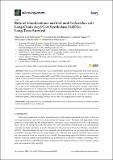Por favor, use este identificador para citar o enlazar a este item:
http://hdl.handle.net/10261/209464COMPARTIR / EXPORTAR:
 SHARE SHARE
 CORE
BASE CORE
BASE
|
|
| Visualizar otros formatos: MARC | Dublin Core | RDF | ORE | MODS | METS | DIDL | DATACITE | |

| Campo DC | Valor | Lengua/Idioma |
|---|---|---|
| dc.contributor.author | Pech-Canul, Ángel de la Cruz | - |
| dc.contributor.author | Rivera-Hernández, Geovanny | - |
| dc.contributor.author | Nogales, Joaquina | - |
| dc.contributor.author | Geiger, Otto | - |
| dc.contributor.author | Soto, María José | - |
| dc.contributor.author | López-Lara, Isabel M. | - |
| dc.date.accessioned | 2020-04-28T14:07:10Z | - |
| dc.date.available | 2020-04-28T14:07:10Z | - |
| dc.date.issued | 2020-03-26 | - |
| dc.identifier.citation | Microorganisms 8(4): 470 (2020) | - |
| dc.identifier.issn | 2076-2607 | - |
| dc.identifier.uri | http://hdl.handle.net/10261/209464 | - |
| dc.description | © 2020 by the authors. | - |
| dc.description.abstract | FadD is an acyl-coenzyme A (CoA) synthetase specific for long-chain fatty acids (LCFA). Strains mutated in fadD cannot produce acyl-CoA and thus cannot grow on exogenous LCFA as the sole carbon source. Mutants in the fadD (smc02162) of Sinorhizobium meliloti are unable to grow on oleate as the sole carbon source and present an increased surface motility and accumulation of free fatty acids at the entry of the stationary phase of growth. In this study, we found that constitutive expression of the closest FadD homologues of S. meliloti, encoded by sma0150 and smb20650, could not revert any of the mutant phenotypes. In contrast, the expression of Escherichia coli fadD could restore the same functions as S. meliloti fadD. Previously, we demonstrated that FadD is required for the degradation of endogenous fatty acids released from membrane lipids. Here, we show that absence of a functional fadD provokes a significant loss of viability in cultures of E. coli and of S. meliloti in the stationary phase, demonstrating a crucial role of fatty acid degradation in survival capacity. | - |
| dc.description.sponsorship | This research was funded by grants from CONACyT/Mexico (153998 and 253549), from the Spanish Ministry /MINECO/MCIU/AEI (BIO2013-42801-P and PGC2018-096477-B-I00) and FEDER funds (EU). The APC was funded by Universidad Nacional Autónoma de México. G.R-H was supported by a postdoctoral fellowship from the DGAPA (Dirección General de Asuntos del Personal Académico)-UNAM (Universidad Nacional Autónoma de México). Á.d.l.C.P.-C. was supported by CONACyT through the “Cátedras CONACyT para Jóvenes Investigadores” Programme (Project #609). | - |
| dc.publisher | Multidisciplinary Digital Publishing Institute | - |
| dc.relation | info:eu-repo/grantAgreement/MINECO/Plan Estatal de Investigación Científica y Técnica y de Innovación 2013-2016/BIO2013-42801-P | - |
| dc.relation | info:eu-repo/grantAgreement/AEI/Plan Estatal de Investigación Científica y Técnica y de Innovación 2017-2020/PGC2018-096477-B-I00 | - |
| dc.relation | PGC2018-096477-B-I00/AEI/10.13039/501100011033 | - |
| dc.relation.isversionof | Publisher's version | - |
| dc.rights | openAccess | - |
| dc.subject | Long-chain acyl-CoA synthetase | - |
| dc.subject | Free fatty acids | - |
| dc.subject | Sinorhizobium (Ensifer) | - |
| dc.subject | Surface motility | - |
| dc.subject | Survival | - |
| dc.subject | Malonyl-CoA synthetase | - |
| dc.title | Role of Sinorhizobium meliloti and Escherichia coli long-chain Acyl-CoA synthetase FadD in long-term survival | - |
| dc.type | artículo | - |
| dc.identifier.doi | 10.3390/microorganisms8040470 | - |
| dc.description.peerreviewed | Peer reviewed | - |
| dc.relation.publisherversion | https://doi.org/10.3390/microorganisms8040470 | - |
| dc.identifier.e-issn | 2076-2607 | - |
| dc.date.updated | 2020-04-28T14:07:10Z | - |
| dc.rights.license | http://creativecommons.org/licenses/by/4.0/ | - |
| dc.contributor.funder | Ministerio de Economía y Competitividad (España) | - |
| dc.contributor.funder | Ministerio de Ciencia, Innovación y Universidades (España) | - |
| dc.contributor.funder | Agencia Estatal de Investigación (España) | - |
| dc.contributor.funder | Consejo Nacional de Ciencia y Tecnología (México) | - |
| dc.contributor.funder | European Commission | - |
| dc.contributor.funder | Universidad Nacional Autónoma de México | - |
| dc.relation.csic | Sí | - |
| dc.identifier.funder | http://dx.doi.org/10.13039/501100011033 | es_ES |
| dc.identifier.funder | http://dx.doi.org/10.13039/501100003141 | es_ES |
| dc.identifier.funder | http://dx.doi.org/10.13039/501100000780 | es_ES |
| dc.identifier.funder | http://dx.doi.org/10.13039/501100003329 | es_ES |
| dc.identifier.funder | http://dx.doi.org/10.13039/501100005739 | es_ES |
| dc.identifier.pmid | 32225039 | - |
| dc.type.coar | http://purl.org/coar/resource_type/c_6501 | es_ES |
| item.openairecristype | http://purl.org/coar/resource_type/c_18cf | - |
| item.fulltext | With Fulltext | - |
| item.cerifentitytype | Publications | - |
| item.openairetype | artículo | - |
| item.grantfulltext | open | - |
| Aparece en las colecciones: | (EEZ) Artículos | |
Ficheros en este ítem:
| Fichero | Descripción | Tamaño | Formato | |
|---|---|---|---|---|
| microorganisms-08-00470-v2.pdf | 2,7 MB | Adobe PDF |  Visualizar/Abrir |
CORE Recommender
PubMed Central
Citations
3
checked on 10-abr-2024
SCOPUSTM
Citations
4
checked on 15-abr-2024
WEB OF SCIENCETM
Citations
4
checked on 26-feb-2024
Page view(s)
135
checked on 19-abr-2024
Download(s)
121
checked on 19-abr-2024

